Search Results
MTC funding plan of state budget funds for transit operations bolsters regional coordination efforts
The Metropolitan Transportation Commission’s approval today of state budget funds and other regional funds for Bay Area transit agencies bolsters an ongoing regional coordination effort and provides essential stopgap operational funding for transit in the Bay Area. Today’s action is a culmination of hard work led by transit agencies and the MTC to advocate for operations funding to ensure continued transit service throughout the Bay Area.
MTC Commissioners approved a distribution framework for an anticipated $447M in state budget funds from Senate Bill 125 and approximately $300 million of regionally controlled funds to transit agencies while requiring that the agencies enhance the customer experience and improve internal efficiency.
Bay Area transit General Managers are meeting on a weekly basis to enhance coordination between agencies and improve connectivity. This transit network coordination work will require more funding to ensure agencies can continue to run reliable service while also focusing on new enhancements.
A key component in the decision to allocate these funds will be the continuing implementation of the Transit Transformation Action Plan, a comprehensive plan for better regional transit coordination and improved rider experience. It encompasses closer fare coordination such as the Clipper BayPass pilot, the expansion of Clipper START offering discounts for low income riders, free or discounted transfers between systems, aligning schedules so it’s easier for riders to make connections between agencies, and more understandable mapping and wayfinding with a uniformed approach to signs to help riders navigate their way through transit systems.
While state funds are vital to continue near-term operations, they fall short of the Bay Area’s funding needs beyond FY26. The MTC and the Bay Area transit agencies are studying options for additional revenues including a regional transportation measure in 2026.
MTC plans to revisit the estimated needs for all operators each year to program the following year’s funding. The proposed programming amounts for all operators across FY25 and FY26 are included in the table below.

Transit agency General Managers praise the new funding and support.
BART General Manager Bob Powers said, “This funding from the MTC supports BART’s new Safe and Clean Plan to welcome riders back to our system and it buys us time to explore a sustainable funding model while avoiding devasting service cuts. Our latest data shows our investments are paying off with great improvements in reliability and police presence. BART is also committed to continue working with all Bay Area transit agencies on transformational improvements that will improve service for transit dependent riders and make it easy for people to ditch their cars and take transit instead. We want to thank the Commission for their approval of these funds and their leadership throughout this process.”
SFMTA Director of Transportation Jeffrey Tumlin said: “This is very good news for the nearly half a million people who ride Muni every single day. It gives Bay Area transit agencies more time to recover from the impact of the pandemic, which changed commute patterns and is still taking an economic toll on downtown San Francisco. These funds will keep Muni financially stable for longer than we had expected provided that we don’t expand Muni service beyond current levels. We’d like to thank MTC, the state legislature and the governor for their actions to make this happen. We’re proud that despite our financial challenges, Muni service is safe, clean, fast, frequent and reliable -- and we plan to keep it that way.”
Caltrain Executive Director Michelle Bouchard said: “We are grateful to our state leaders for securing these funds and to MTC for the proposed FY26 allocation to Caltrain that will allow us to continue working with our regional partners to coordinate an easy and integrated experience for Bay Area transit riders. With the launch of electrified service next year, Caltrain will greatly improve our service and the rider experience. Electrification will mean up to 25 minutes in time savings on local trips and increase of service to all the stations, including half hour service during weekends and off-peak hours. The trains will have wi-fi, power outlets at every seat and new safety features. We are proud to keep working on a world-class, modern and climate friendly system that the region deserves.”
Golden Gate Bridge, Highway and Transportation District General Manager Denis Mulligan said: “We want to thank MTC, the state legislature, and the governor for their continued support of Bay Area transit. These funds are a much-needed shot in the arm that will help us provide first-class bus and ferry service for our customers into the future. We look forward to continued collaboration with our transit agency partners to roll out even more improvements for Bay Area riders.”
Innovative pilot program results in promising ridership growth for Bay Area transit agencies
New data shows Clipper BayPass a huge success in encouraging the use of transit as it enters its next phase
A two-year pilot program designed to test how an unlimited transit pass would work in the Bay Area has recorded more than 2 million trips among participants in its first year of existence. Clipper BayPass provides 50,000 college students and affordable housing residents with a Clipper card that allows them free, unlimited rides on more than two dozen Bay Area transit systems.
The next phase of the BayPass pilot program involves recruiting and enrolling Bay Area employers into the program with an announcement of the first major employer that has committed to offering the benefit to employees being announced in the coming days.
The goal of Clipper BayPass is to measure if giving participants a prepaid card that offers unlimited trips and transfers between systems encourages people to take more transit. The latest numbers measuring ridership from the launch of the pilot in August 2022 to August 2023 paint a clear picture:
*Clipper BayPass cards are logging 40% more trips than the average single-agency Clipper card.
*74% increase in transfers between transit operators
*85% of Clipper BayPass users agree that BayPass helps them travel to new locations in the Bay Area
“In just its first year of existence Clipper BayPass is already establishing itself as a shining example of regional coordination among Bay Area transit agencies,” said BART General Manager Bob Powers. “Clipper BayPass is giving us a vision of the future of Bay Area transit and shows if we make transfers between systems more seamless ridership will increase across the board.”
“It’s exciting to see real-world data on the role fare coordination can play in helping to boost transit ridership,” said Metropolitan Transportation Commission Executive Director Andrew Fremier. “We want to build a more equitable and seamless fare system for the Bay Area. Studying a regional fare pass using students and residents of affordable housing communities shows that commitment.”
Participants in Phase 1 of Clipper BayPass include students at UC Berkeley, San Francisco State University, San Jose State University, and Santa Rosa Junior College as well as residents at affordable housing communities managed by MidPen Housing.
Clipper BayPass is now Recruiting Employers
The next phase of Clipper BayPass involving Bay Area employers launches in January 2024. The program will expand to include about 20,000 employees from a diverse range of employers varying by types of industries, employer sizes, and geographic locations. The program is currently recruiting employers looking to be one of the first to offer their employees the benefits of unlimited transit. More information and an interest form are available at clipperbaypass.com
Funding for the Unlimited Pass Pilot
Clipper BayPass is comanaged by the Metropolitan Transportation Commission (MTC) and BART. The MTC Commission has allocated $4.5 million to reimburse transit operators for the cost of trips taken during the first phase of the program. In Phase 2, participating employers will pay MTC for employee transit passes and MTC will reimburse transit operators for employee trips taken.
Normal train service has resumed between Richmond and MacArthur Station
As of 11:10am, we have restored normal train service between Richmond and MacArthur. We will follow up with more details about the cause of the disruption on Monday.
In an effort to improve communication during disruptions we are asking impacted riders to take this short survey before Monday, May 13th, at 5pm:
bart.gov/delays
We currently have no Red or Orange line service between Richmond and MacArthur due to a wayside equipment problem. Crews are on scene and are trouble shooting the problem. We hope to have this resolved shortly but expect this service disruption to last through the morning commute. The Yellow, Green and Blue lines are not impacted, and we do have normal service throughout the rest of the system.
Richmond riders should seek other means to get to MacArthur Station. Richmond through Ashby station riders should use the existing bus service at each station. For Millbrae riders, take the shuttle train between SFO and Millbrae and transfer to/from the Yellow line (Antioch-SFO). Orange line service is running MacArthur to Berryessa.
While we do have extra staff at each station to help with buses, there isn’t a direct bus bridge. We do have mutual aid from Capitol Corridor and various bus agencies that varies from Station to Station.
Capitol Corridor will offer free rides to BART passengers only between Richmond and Oakland Coliseum until 3PM.
BUSES TO DOWNTOWN SAN FRANCISCO
Richmond Station
- 72M to NL (AC Transit)
- Transfer from 72M to NL at 20th/Broadway in Oakland
- Takes 1 hour and 25 minutes
El Cerrito del Norte
- 72/72M to NL (AC Transit)
- Transfer from 72M to NL at 20th/Broadway in Oakland
- Takes 1 hour and 7 minutes
- L (AC Transit)
- Takes 48 minutes
- 72/72M/72R to G (AC Transit)
- Transfer at San Pablo and Gilman
- 48 minutes
- 72/72M to F (AC Transit)
- Transfer at San Pablo and 40th
- 53 minutes
El Cerrito Plaza
- G (AC Transit)
- 54 minutes
- L (AC Transit)
- Walk from station to San Pablo and Central
- 42 minutes
- 72/72M to NL (AC Transit)
- Transfer from 72M to NL at 20th/Broadway in Oakland
- Takes 55 minutes
- 72/72M to F (AC Transit)
- Transfer at San Pablo and 40th
- 51 minutes
North Berkeley
- J (AC Transit)
- Walk to Sacramento and University
- Takes 48 minutes
- G (AC Transit)
- Walk to San Pablo and Delaware
- Takes 41 minutes
o Casual Carpool: https://sfcasualcarpool.com/
Downtown Berkeley
- F (AC Transit)
- Takes 41 minutes
Ashby
- F (AC Transit)
- Takes 37 minutes
LOCAL OPTIONS for travel between stations.
Richmond Station – El Cerrito del Norte – El Cerrito Plaza
- AC Transit 72/72M
North Berkeley – Downtown Berkeley
- AC Transit 52
MacArthur – Ashby – Downtown Berkeley
- AC Transit 6
- AC Transit 18
Downtown Berkeley – Rockridge
- AC Transit 51B
- AC Transit 79
Report a Hot or Cold Car
Parking Maps & Pricing
Hayward Station: Passenger loading zone temporarily moved 10/9/2023 through 10/13/2023
The Hayward Station passenger loading zone will be temporarily moved from Monday, October 9, 2023 and Friday, October 13, 2023 so that improvements to the sidewalk can be made.
While the sidewalks improvements are being made, the passenger loading zone will be moved to the parking lot area nearest the station entrance (see area outlined in picture). Motorcycles can park for free in any space on the other side of the station during the construction. Temporary wayfinding signage will be posted to direct customers.
Thank you for your patience as we work to improve access to the BART Station.

Single Tracking Alert: Service to be reduced to one track between Hayward and Union City on Sunday 11/5/23 for tree removal work
On Sunday, November 5 a work crew will be cutting back and removing trees that could pose a hazard to the trackway near Hayward Station. To ensure safe conditions for workers, service will be reduced from two to one track all day between Hayward and Union City stations. Green Line trains will be cancelled. Riders travelling to San Francisco can use the Orange Line and transfer to a Blue Line train at Bay Fair Station. Riders on the Orange Line between Berryessa and Bay Fair stations should anticipate delays of up to 20 minutes.
You can get more details about BART’s systemwide safety initiative to remove potentially hazardous trees at the project page.
Planned Clipper maintenance will impact some services 9/19/23-9/20/23
Due to scheduled maintenance, Clipper customers will not be able to do the following from 9 p.m. September 19, 2023 to 9 a.m. September 20, 2023:
- Get a card or add value to a card on the Clipper website or app and through Apple and Google digital wallets.
- Check balances on the Clipper website or mobile app.
- Get account information or add value from the phone system.
- Get a card or add value to their cards at a retailer.
During this time, customers will still be able to add value to their cards at BART, Muni and other transit agency ticket machines. They also will be able to tap their plastic or mobile card to pay their fares.
We thank you for your patience and apologize for the inconvenience.
Clipper is run by the Metropolitan Transportation Commission.
Entrance Closure Alert: Montgomery St. entrance near Sutter and Sansome to close for canopy work
An entrance to Montgomery Street Station near Sutter and Sansome Streets is scheduled to close October 18th for construction of a new canopy. The entrance is expected to remain closed until Spring 2024.
Three alternative entrances will remain open, including the entrance at Montgomery and Post Streets where a new canopy has just been completed.
BART has finished six canopies over station entrances along Market Street and 13 more will be built, including the canopy at the entrance referenced above. The new canopies protect escalators and provide additional wayfinding, lighting, real-time information and security cameras.
The canopy project is proceeding in conjunction with a program to replace 40 escalators and add one new escalator at the four downtown San Francisco stations.
This group has been juggling for joy at Castro Valley Station for nearly two decades
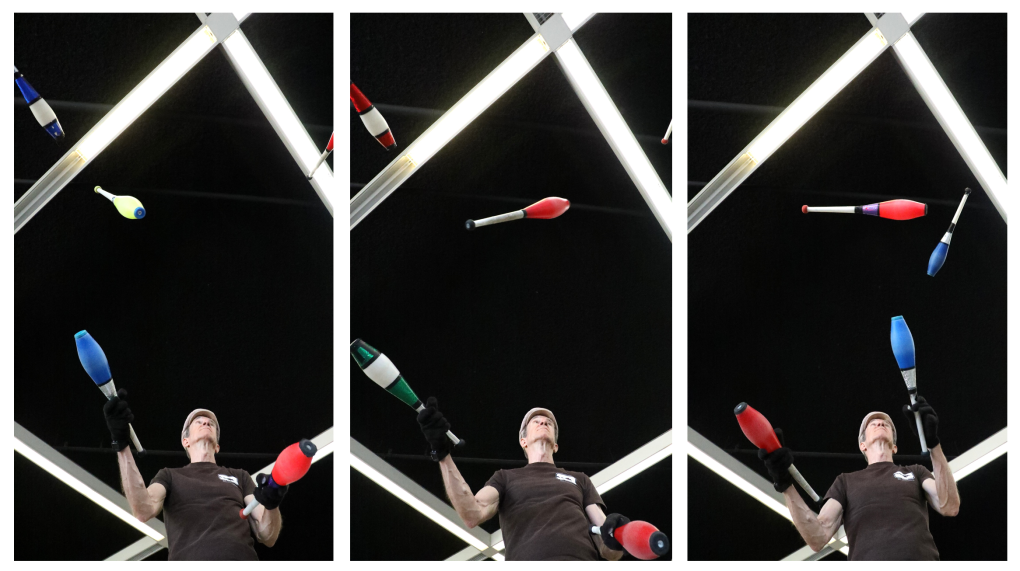
Al Franz juggling at Castro Valley Station during a Tuesday evening meetup in July.
“It’s fun, it’s social, we juggle.”
Those six words, spoken by juggler Tony Flusche, provide a neat summary of the Castro Valley Jugglers Association’s group agreements, if the CVJA had formal agreements.
A good motto for a juggler’s physicality might be loosey-goosey; you’ve got to keep your body and mind focused and relaxed when you’re lobbing balls and clubs (the props that look like bowling pins) and flaming torches into the air (and over people’s heads) then catching them.
It’s also an apt motto for a group of jugglers who’ve been meeting informally to practice and swap clubs at Castro Valley Station for just about two decades. The association meets every single week in the free area of the station – under the rotunda – from 6pm to 8:30pm or so. Members of the group – before they began practicing at Castro Valley Station – performed at the station’s official opening in 1997.
“Sometimes we get up to 30 people at a session; sometimes no one shows up at all,” said juggler James Johnson. “Sometimes we’re the Castro Valley Sit and Gab Association.”
Johnson is a former student of Louis Kruk, a longtime Physical Education teacher at Canyon Middle School in Castro Valley. He’s the main throughline that connects this ragtag group of juggling fiends.

Louis Kruk is pictured juggling at Castro Valley Station during a Tuesday evening meetup in July.
When he was a middle school teacher, Kruk would interject a juggling unit between more traditional sporting units, like football and volleyball. He himself learned to juggle after he was gifted the classic instructional book Juggling for the Complete Klutz on a snowy Christmas in Tahoe many decades ago (The Klutz book, still in print, released its 30th anniversary edition in 2007).
The thing about juggling is it’s best to do with other people. Alone, you can toss the balls up and down, up and down, add and subtract clubs, and introduce certain elements, like unicycles or fire. But in the company of others, you can practice different, complex patterns.
“Passing clubs is the social activity of jugglers,” Kruk said. “I can stay home and juggle, or I can come here and pass clubs. If you mess up in a weird way, we’ll still have fun with that.”
On some Tuesday evenings after school, Kruk would open the school gym to students and local adults who wanted to juggle with each other. Kruk, now 78 and long retired, said he was selfishly motivated in some ways; he wanted folks to pass clubs with, too. At these meetups, if you didn’t know how to juggle already, people would teach you the basics and then integrate you into their passing patterns.
After Kruk retired, school administrators wanted him to start renting the gym more formally. So, he decided to change venues. Castro Valley Station was the ideal spot: easy to get to, centrally located, well-lit, and protected from the elements, including every juggler’s kryptonite – wind.
“Look at this place, it could be pouring down rain and you can still juggle,” he said.
The jugglers not only entertain riders – and are careful to stay safely out of the way of people entering and exiting the station – but serve as an extra set of ears and eyes for the Station Agent on duty, Kruk said.
Norman Hollis, a BART System Service Worker stationed at Castro Valley, is fond of the jugglers himself.
“They’re here every Tuesday. It’s truly amazing what they do,” he said. “It brings the community together; a lot of people stop to watch.”
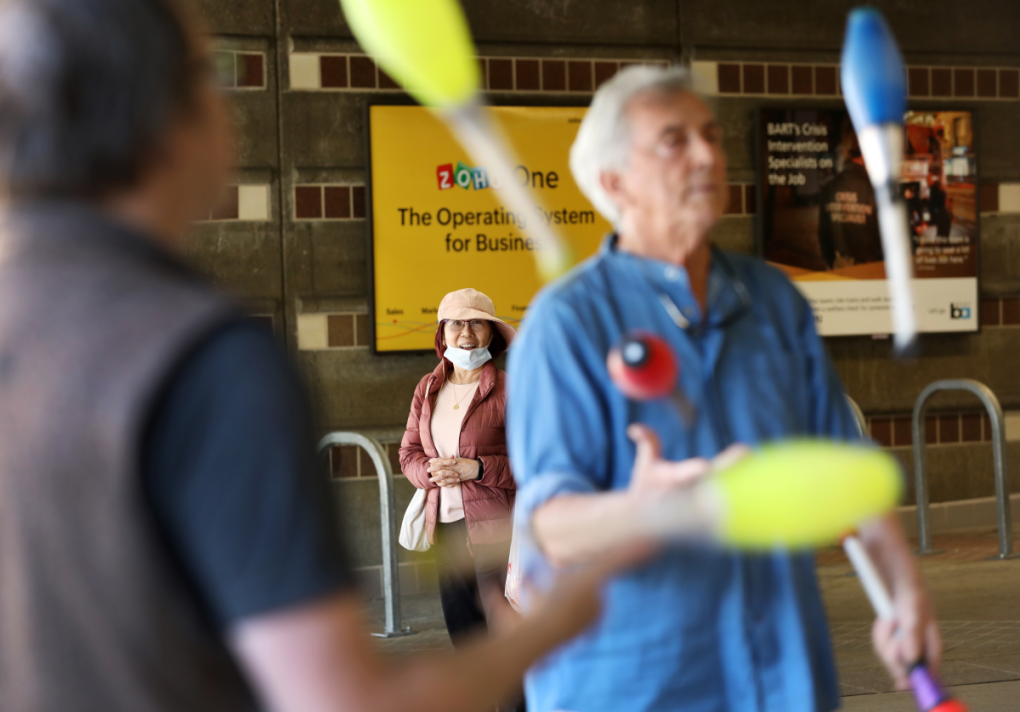
A rider leaving Castro Valley Station stops to watch the jugglers on a Tuesday evening meetup in July.
On this particular Tuesday, the group began with three men. They warmed up with a basic four count – 1 2 3 4, 1 2 3 4, 1 2 3 4 – and then practiced their two counts. As the clubs flew overhead, hand to hand, they melted into a sort of cosmic mush in which it was no longer clear which club came from where and whose hand. When one juggler dropped a club, the rest of the jugglers kept on, adapting the pattern until the juggler who dropped could jump back in. Throughout, the group made casual conversation, often swapping barbs of the dad-joke ilk.
The light plastic clubs look like Space Age versions of the wooden club Bamm-Bamm Rubble tosses over his shoulder in The Flintstones. When the clubs hit the ground, which they inevitably do, they bounce and make a sort of hollow clang sound. Members of BART Communications were assured the clubs do not hurt if they land on you (assurances we were given before we were conscripted to briefly stand in the center of a juggling pattern, clubs whirling past our heads).
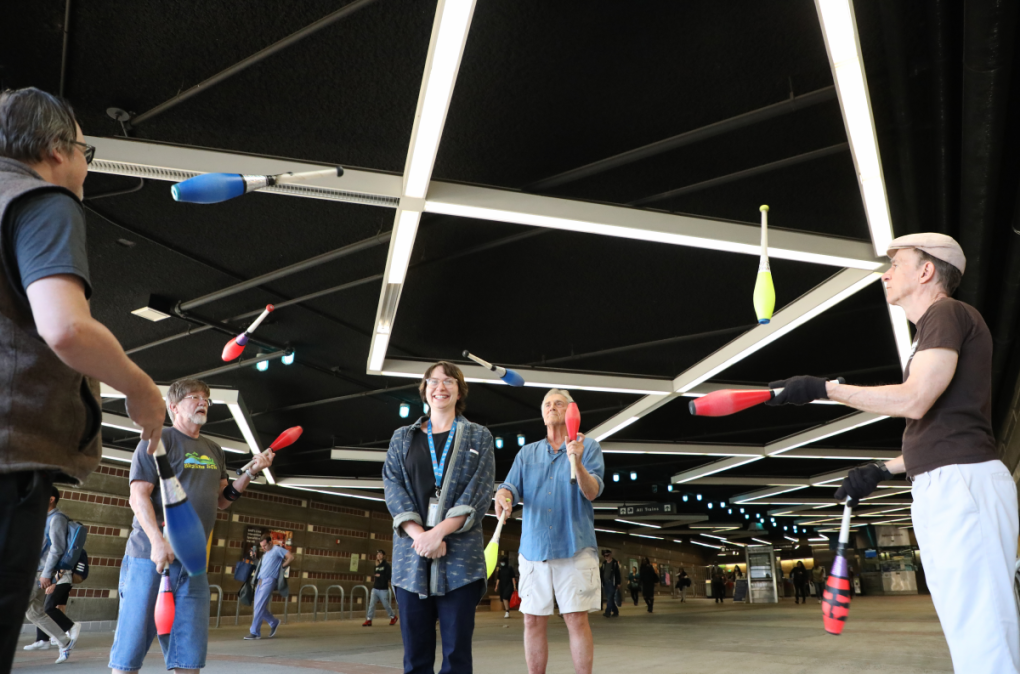
Jugglers toss clubs around a willing member of BART Communications at Castro Valley Station during a Tuesday evening meetup in July.
“Y’all comfortable with Havana?” one juggler asked the small group. They got into formation: three jugglers standing on one side with one facing them. Then they rotated around each other as if waltzing, tossing clubs all the while.
A few minutes into the practice session, another juggler appeared.
“Ray, get your clubs out,” barked Flusche. "Now we can do a star.”
By 6:30pm, six jugglers had shown up. It’s decided they will practice a “sweep feed,” where a feeder passes each feedee a club along the line from left to right then right to left – you sort of have to see it to get it.
“At parades, we do this with torches!” said Flusche, the consummate showman of the group.
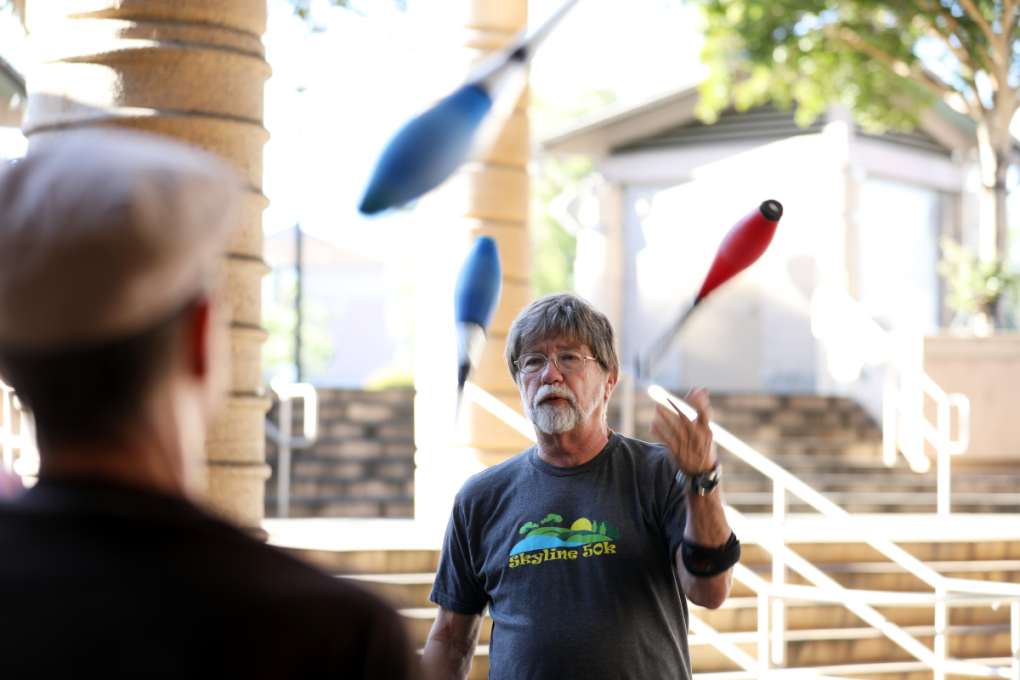
Tony Flusche is pictured juggling at Castro Valley Station during a Tuesday evening meetup in July.
Flusche joined the association in 1995 after meeting Kruk through a juggling course he was teaching at Castro Valley Adult School. Flusche pointed out that many of the jugglers’ bonds run deep. For example, “Joe and I unicycle together,” he said.
Johnson, Kruk’s former middle school student, said he found juggling during a college speech class, in which the teacher demonstrated informative speech by giving a talk on how to juggle. The class then juggled.
Fastforward some years, and Johnson finds himself with an Australian cattle dog that likes to run. He buys the dog a pack of 47 tennis balls and takes him to the park, passing the time by tossing the balls for a fetch and juggling them, too. (“Tennis balls are terrible to juggle with,” he noted).
One day, a neighbor came over and said, “I’ve seen you juggling...you should check out this group.” So, Johnson did, only to find out it was run by Kruk.
“I was terrified of him! Sports were not my thing in school,” Johnson said of his former teacher. The two have now set aside their sporting differences.
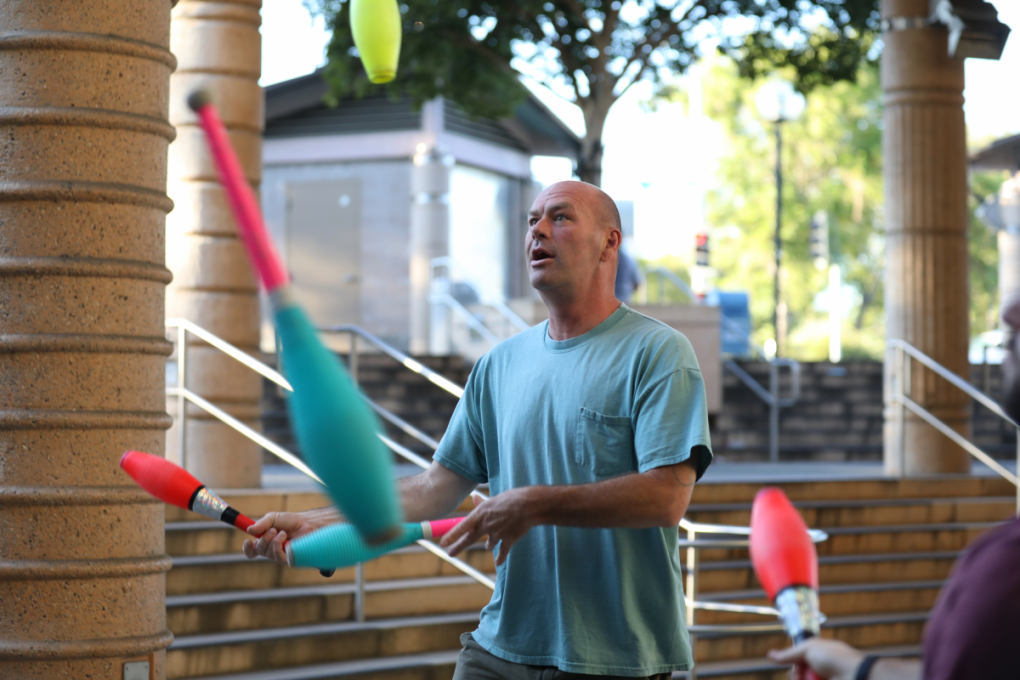
James Johnson is pictured juggling at Castro Valley Station during a Tuesday evening meetup in July.
Another juggler in attendance was Bob Mendelsohn, a former pro-juggler who hasn’t “been a pro juggler in this century,” he said. He revealed he once juggled on a unicycle around the Mighty Morphin Power Rangers. He juggles just for fun now.
The swashbuckling cast of characters are obviously unified by a singular passion – a singular passion that’s best shared with others. There is plenty of room for jugglers in the group, seasoned or klutzy, he added.
“I’ll start a pattern with any juggler who shows up. If you’re passing by, I might ask you to join us, too,” Kruk said. “Even if you don’t have great skill, we can always find a spot for you."